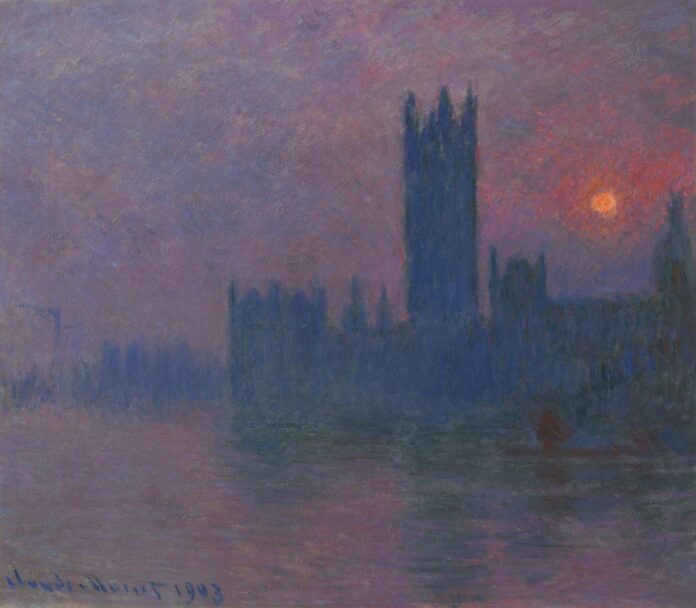The dreamy haziness that defines much of Claude Monet’s work has long been chalked up to the artistic aims of Impressionism, the movement with which he has long been synonymous. But a new scientific study suggests that the French painter’s signature look wasn’t just a question of style—that, in fact, it maybe had more to do with the early effects of climate change.
The report, published earlier this year in a peer-reviewed journal called Proceedings of the National Academy of Sciences (PNAS), argues that the works of Monet and a British artist that proceeded him, J.M.W. Turner, reflect changes in air pollution caused by the Industrial Revolution.
“I work on air pollution and while seeing Turner, Whistler, and Monet paintings at Tate in London and Musée d’Orsay in Paris, I noticed stylistic transformations in their works,” one of the study’s co-authors, Anna Lea Albright, told CNN.
Albright, a postdoctoral researcher for Le Laboratoire de Météorologie Dynamique at Sorbonne University, explained that “the contours of [these artist’s] paintings became hazier, the palette appeared wider, and the style changed from more figurative to more impressionistic. Those changes accord with physical expectations of how air pollution influences light,” she added.

J.M.W. Turner, The Burning of the Houses of Lords and Commons, 16 October 1834 (1835).
With her fellow author, a Harvard University professor of Earth and planetary sciences named Peter Huybers, Albright examined nearly 100 paintings by Monet and Turner. They were interested in two particular metrics: edge strength and whiteness, which they calculated through mathematical analyses of brightness.
“In general, air pollution makes objects appear hazier, makes it harder to identify their edges, and gives the scene a whiter tint, because pollution reflects visible light of all wavelengths,” Albright pointed out.
The two researchers compared the results of their findings with historical air pollution estimates. “We found that there was a surprisingly good match,” Albright said.
Indeed, across both Monet and Turner’s works, the report identified progressions from “sharp to hazier contours, more saturated to pastel-like coloration, and figurative to Impressionistic representation.” Those progressions mirrored atmospheric changes in Paris and London—the two locations primarily depicted by the artists—during the 19th century, when the amount of coal extracted in western Europe rose precipitously to support industrial manufacturing demands.
“Our basic premise is that Impressionism… contains elements of polluted realism,” Albright and Huybers’s study concluded. “Over the 19th century, the atmospheric reality in London and Paris changed. Turner, Monet, and others document these changes in paint, yielding proxy evidence for historical trends in atmospheric pollution before instrumental measurements of air pollution become available.”

Claude Monet, (1903).
This is not the first time that scholars have hazarded a connection between the atmospheric effects of Industrial Revolution-era production and the concurrent developments of Impressionism. The same idea was proffered in an essay by Boston University European art professor Jonathan Ribner, written on the occasion of Tate Britain’s 2004 “Turner Whistler Monet” exhibition. The Tate even organized a special conference on “the aesthetics of pollution.”
But the idea hasn’t always sat well with the art history crowd. Earlier this year, Washington Post art critic Sebastian Smee sounded off on Albright and Huybers’s study, calling it “terribly facile.”
“There are many reasons the look of pictures changes,” the critic wrote. “Monet was famous for his desire to depict the world as he saw it, but you cannot read even his work as a straightforward index to external conditions such as pollution levels. Paintings are not like tree rings or geological studies. They are complex products of human imagination, feeling, and philosophy.”
The study, Smee went on, “mistakes correlations for causes. It is grossly (and trendily) tendentious. And it ignores whole bodies of exhaustively researched and powerfully argued literature, presumably because that literature falls under the category of the ‘humanities’ rather than the ‘sciences,’ and because no one these days can be made to believe anything that doesn’t have metrics attached.”
Responding to these and other critiques, Albright told CNN that she and Huyber did not intend to simply reduce art to metrics.
“What I think is really wonderful about these works is that Monet creates beautiful atmospheric effects from something as ugly and dirty as smoke and soot,” she said. “He and Turner, they don’t turn away from the pollution, but they were able to transform these negative environmental changes into a source of creative inspiration.”

























